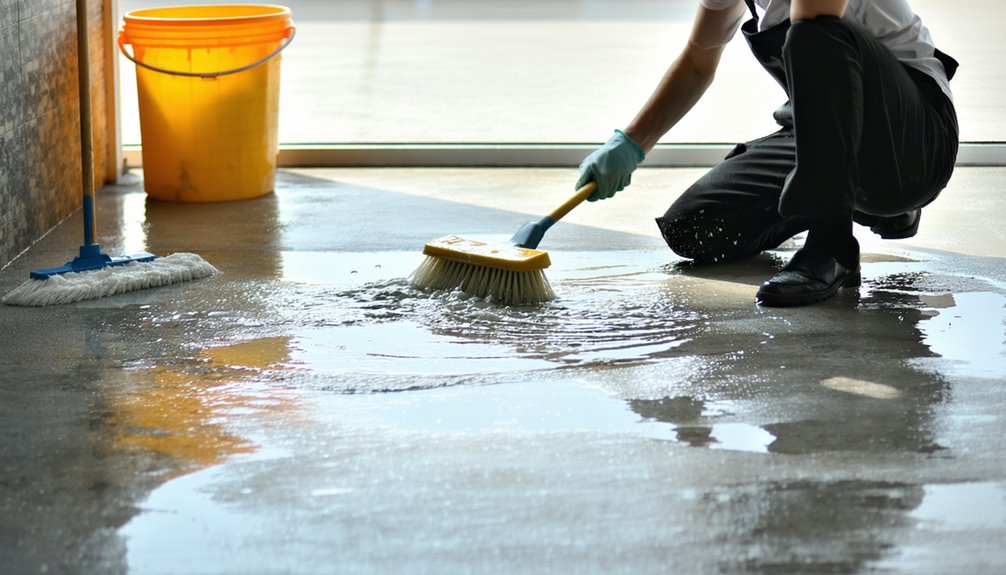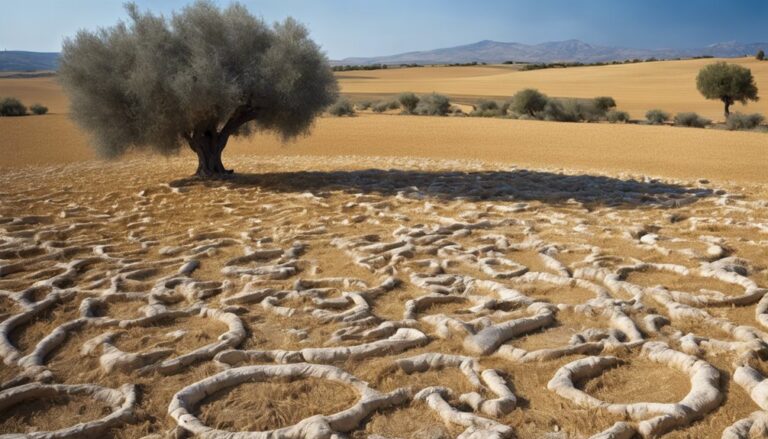To clean your concrete floor, start by evaluating its condition for cracks, stains, and wear. Gather essential supplies like a broom, vacuum, mop, and appropriate cleaners. Begin by sweeping and vacuuming to remove loose debris before mopping with a damp solution. For stains, identify their type and apply suitable eco-friendly cleaners, such as a baking soda mix for oil or vinegar and water for mildew. Always follow up with a thorough inspection and consider sealing your floor every few years. This methodical approach not only cleans effectively but also guarantees longevity, and you can discover more tips to enhance your cleaning routine.
Assessing Your Concrete Floor
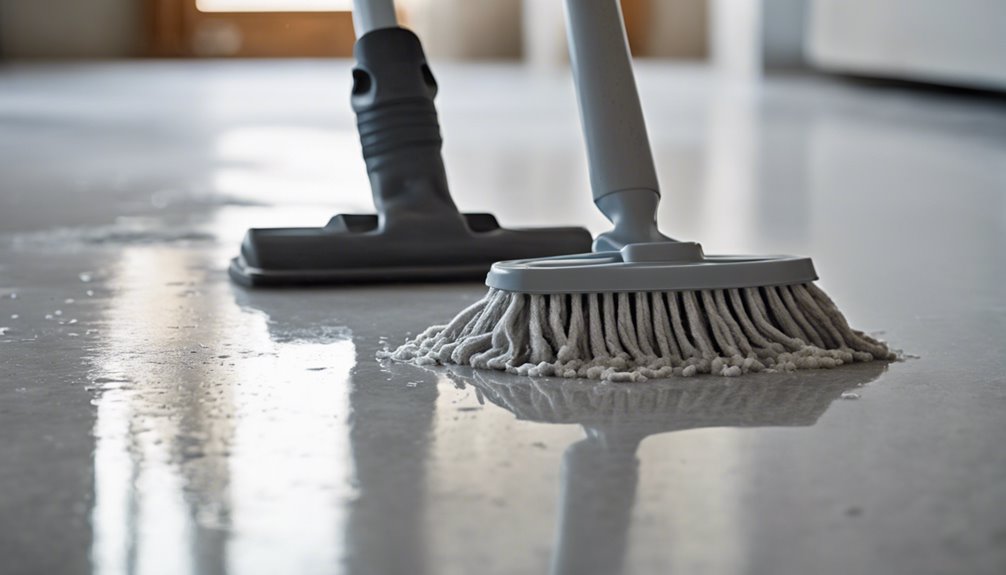
Before you immerse yourself in cleaning your concrete floor, it's important to assess its condition thoroughly. Start by examining the surface texture; is it smooth, rough, or perhaps stained? Each type of texture may require a different cleaning approach. Check for cracks, chips, or wear patterns that could indicate deeper issues. Don't forget to reflect on any existing stains from oil, paint, or other substances that may need special attention. Understanding the floor condition will help you choose the right cleaning methods and products, ensuring effective results. By taking the time to evaluate these factors, you empower yourself to maintain the beauty and durability of your concrete floor, giving you the freedom to enjoy a pristine space in your home or business.
Gathering Cleaning Supplies
As you prepare to clean your concrete floor, gathering the right supplies is essential for achieving ideal results. Start by ensuring you have the necessary cleaning tools and safety gear. Here's a quick list to help you get organized:
| Cleaning Tools | Safety Gear |
|---|---|
| Broom or vacuum | Gloves |
| Mop or scrub brush | Safety goggles |
| Bucket | Face mask (optional) |
| Concrete cleaner | Non-slip shoes |
| Sponge or cloth | Knee pads (for comfort) |
With these items in hand, you'll be well-equipped to tackle any mess. Remember, proper safety gear not only protects you but also enhances your cleaning efficiency. Get ready to transform your concrete floor!
Removing Loose Debris
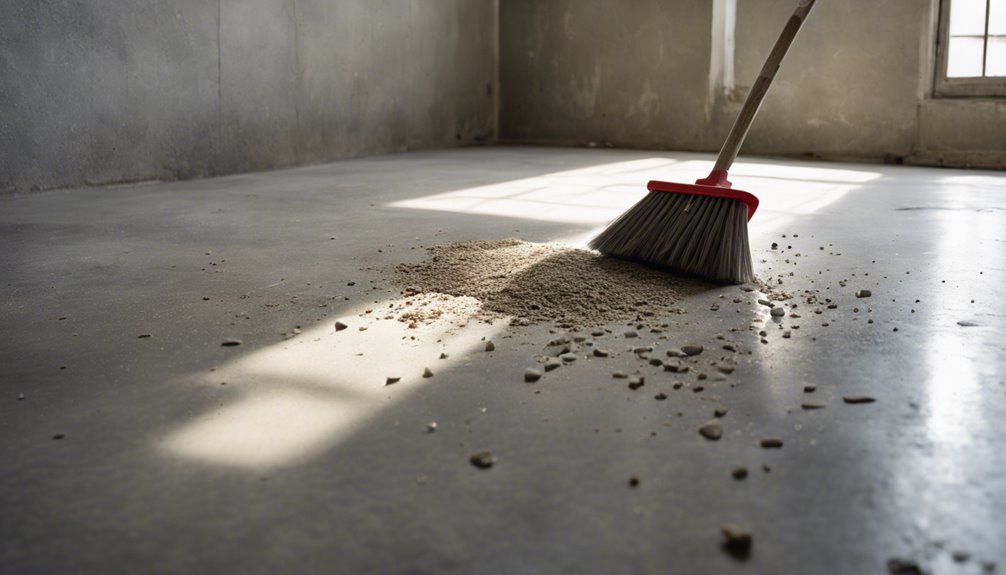
With your cleaning supplies ready, it's time to focus on removing loose debris from your concrete floor. This step is essential for achieving a clean surface and preparing for deeper cleaning. Different debris types can include dirt, dust, leaves, and small stones. Here's how to tackle it:
- Broom: Use a sturdy broom to gather larger debris.
- Vacuum: A shop vacuum is perfect for sucking up dust and fine particles.
- Dustpan: After sweeping, use a dustpan to collect the debris easily.
- Mop: Finally, a damp mop can help lift any remaining dust or debris.
Treating Stains and Spots
When it comes to treating stains and spots on your concrete floor, identifying the type of stain is essential for effective cleaning. Common stains include oil, rust, and food spills, each requiring specific cleaning solutions for best results. By understanding the nature of these stains, you can select the right approach to restore your floor's appearance.
Common Stains Identification
Identifying common stains on concrete floors is essential for effective treatment, since different stains require specific cleaning methods. Here are some common types you might encounter:
- Oil stains: Often from vehicles, these can seep deep into the concrete.
- Rust marks: Typically from metal objects left on the floor, which can create unsightly discoloration.
- Paint spills: These can be tricky, especially if they dry and bond with the surface.
- Mildew growth: This occurs in damp areas and can lead to health issues if not addressed.
Additionally, watch for tire tracks, food stains, grease spots, and efflorescence issues, as these can affect both the appearance and integrity of your concrete floor. Recognizing these stains early allows for appropriate treatment methods.
Effective Cleaning Solutions
Cleaning concrete floors effectively requires targeted solutions based on the type of stain you're dealing with. For oil stains, consider using eco-friendly cleaners like a mix of baking soda and water. Apply it to the stain, let it sit, then scrub and rinse. For rust, a homemade solution of lemon juice and salt can work wonders; apply it, let it sit, and scrub gently. If you're facing tough mold or mildew, a mixture of vinegar and water acts as a natural disinfectant. For general dirt and grime, a simple soapy water solution will suffice. Always remember to test any cleaner in an inconspicuous area first to avoid damage. With these solutions, you'll maintain your concrete floors with ease.
Deep Cleaning Techniques
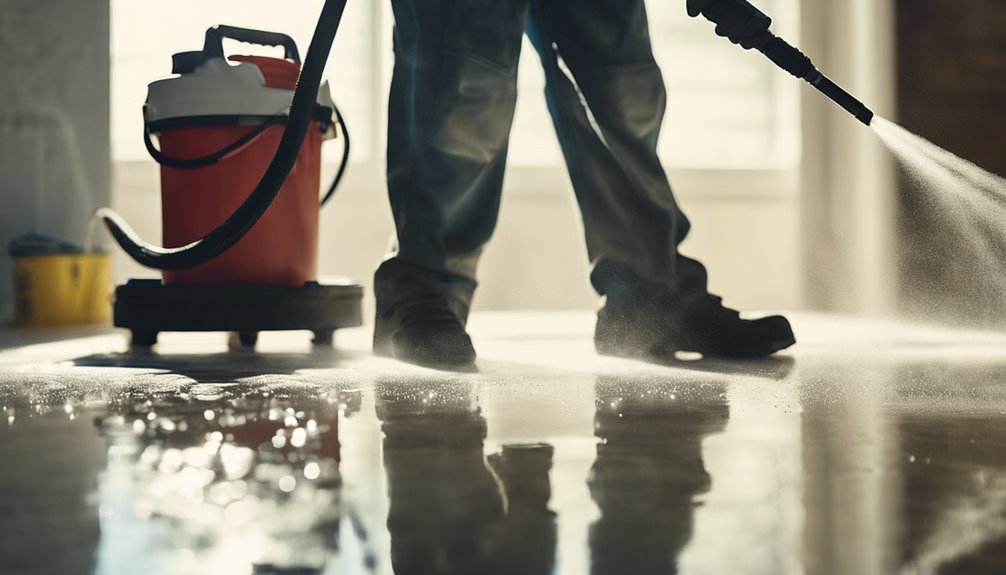
Before you begin the deep cleaning process, it's essential to prepare your concrete surface properly. This includes gathering effective cleaning solutions that will tackle embedded dirt and grime. Once cleaned, sealing the surface will help protect it from future wear and staining, ensuring your floor remains in ideal condition.
Pre-Cleaning Preparation Steps
Proper preparation is crucial for achieving a spotless concrete floor, and following a few essential steps can make a significant difference in your deep cleaning efforts. Before diving into cleaning techniques, verify thorough surface preparation by completing these steps:
- Clear the Area: Remove all furniture, rugs, and items from the concrete surface.
- Sweep and Vacuum: Eliminate loose dirt, dust, and debris using a broom and vacuum cleaner.
- Inspect for Stains: Identify any stubborn stains or areas that require special attention.
- Moisten the Surface: Lightly dampen the concrete to help lift dirt during cleaning.
Effective Cleaning Solutions
While achieving a pristine concrete floor may seem challenging, using the right cleaning solutions can make the process straightforward and effective. You can choose from various eco-friendly options or opt for homemade cleaners that are both safe and powerful.
| Cleaning Solution | Ingredients | Best For |
|---|---|---|
| Vinegar Solution | 1 part vinegar, 1 part water | General cleaning |
| Baking Soda Paste | 1 cup baking soda, water | Stains and scuff marks |
| Castile Soap Mix | 2 tablespoons Castile soap, 1 gallon water | Grease and grime |
Using these methods, you can maintain your concrete floor's appearance without harsh chemicals, ensuring a clean and inviting space.
Sealing and Protecting Surface
When you want to guarantee your concrete floor remains in top condition, sealing and protecting its surface is essential. Choosing the right sealant types can greatly enhance durability and aesthetics. Here are some steps to guarantee effective surface protection:
- Choose the right sealant: Consider options like acrylic, epoxy, or polyurethane based on your floor's needs.
- Clean thoroughly: Deep clean your surface to remove any dirt or debris before applying the sealant.
- Apply evenly: Use a roller or sprayer for a uniform application, avoiding puddles.
- Allow proper curing: Follow the manufacturer's instructions regarding drying times to guarantee the sealant bonds effectively.
Drying and Finishing Touches
As the cleaning process comes to a close, allowing your concrete floor to dry thoroughly is essential for achieving the best finish. Utilize effective drying techniques like fans or dehumidifiers to speed up the process, ensuring no moisture lingers to interfere with the final results. Depending on your desired look and functionality, explore various finishing options, such as high-gloss sealers or matte finishes, to enhance the floor's appearance and durability. Consider the room's purpose when choosing a finish; for instance, a slip-resistant option may be ideal for high-traffic areas. Once dry, inspect the floor for any imperfections and touch them up as needed, ensuring a flawless, polished look that reflects your style and freedom in design.
Regular Maintenance Tips
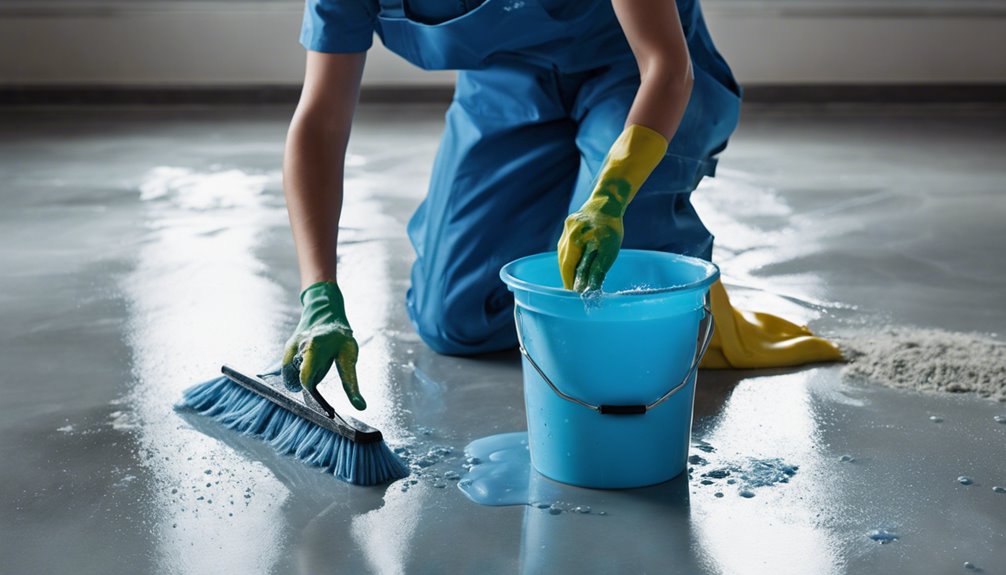
Regular maintenance is essential for keeping your concrete floor looking its best over time. By implementing a few straightforward practices, you can guarantee longevity and aesthetics. Here are some tips for effective maintenance:
- Regular Inspections: Check for cracks or stains to address issues promptly.
- Seasonal Upkeep: Adjust your cleaning schedule based on seasonal demands, like increased dirt in winter.
- Use Appropriate Cleaners: Opt for pH-balanced cleaners to avoid damaging the surface.
- Seal Your Floor: Apply a sealant every few years to protect against stains and wear.
Frequently Asked Questions
Can I Use Bleach on My Concrete Floor?
You might think bleach is your go-to solution for tough stains, but it can actually damage your concrete over time. Instead of risking discoloration or staining, consider bleach alternatives like vinegar or baking soda, which are gentler yet effective. If you're set on using bleach, make sure to dilute it properly and test a small area first. Remember, preserving your concrete's integrity will give you more freedom in your space for years to come!
How Often Should I Deep Clean My Concrete Floor?
You should deep clean your concrete floor at least once every three to six months, depending on foot traffic and exposure to dirt. Establishing a maintenance schedule helps guarantee longevity and appearance. When you do deep clean, use appropriate cleaning products that are safe for concrete. Regularly sweeping and mopping can also keep your floor looking fresh. This methodical approach gives you the freedom to enjoy your space without worrying about buildup and stains.
Is It Safe for Pets During Cleaning?
When it comes to cleaning, guaranteeing pet safety is essential—after all, you wouldn't want to turn your home into a chemical jungle! During cleaning, it's best to keep pets away from areas where you're using harsh cleaning products. Opt for pet-safe alternatives whenever possible and ventilate the space well. Always read labels carefully to make certain the products won't harm your furry friends. They'll appreciate it, and so will you!
What Type of Mop Is Best for Concrete Floors?
When considering mop types for concrete floors, you'll want to look for options that effectively handle tough stains and dirt. Microfiber mops are excellent due to their ability to trap dust and grime. Spin mops can also be useful, allowing for easy wringing without excessive water. Employing cleaning techniques like damp mopping helps prevent damage while ensuring a thorough clean. Always remember to choose a mop that suits your cleaning style and needs.
Can I Apply a Sealant After Cleaning?
Absolutely, you can apply a sealant after cleaning your concrete floor—it's a game-changer! To choose the right sealant types, consider whether you need a penetrating or topical sealant based on your floor's condition. For application tips, make certain the surface is completely dry and free from debris before you start. Apply evenly using a roller or sprayer, and let it cure as per the manufacturer's instructions for ideal protection and longevity.

